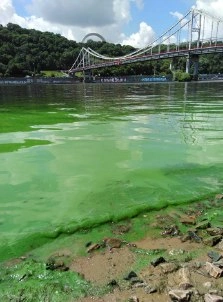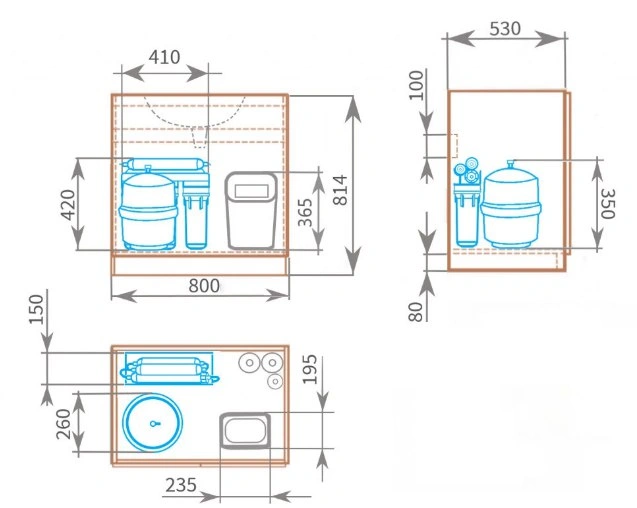There are many opinions regarding the pros and cons of reverse osmosis technology for household use. Some are scientifically based, while others originate from sources such as old publications in local newspapers. Today, we will explore why we need water filters, the potential benefits and drawbacks of reverse osmosis, and provide some insight into how these filters work.
Reverse osmosis has been in use since the 1970s for purifying and desalinating drinking water, producing ultrapure water for medical, industrial, and other needs. It later found applications in food industry water preparation and desalinating seawater in regions with scarce surface and groundwater resources. Today, reverse osmosis is the most widely used water treatment technology across all sectors, including bottled water production.
What’s Wrong with Our Water?
.webp)
It’s no secret that the quality of tap water in Ukraine leaves much to be desired. While it’s technically classified as potable, it often falls short. Deteriorating water sources and aging pipelines—many built in the 1960s and now exceeding their operational lifespan—pose an ongoing threat, with issues like infectious disease outbreaks due to waterborne contaminants becoming more frequent. For instance, hepatitis A, often traced back to water sources, has recently been in the news in Ukraine. Poor chlorination, with chlorine being used up on biofilm deposits in pipes, or accidental mixing of potable water with sewage due to pipeline leaks, contributes to these outbreaks.
Surface water also contains carcinogenic chlorinated organic compounds, as river blooms (e.g., in the Dnipro) lead to microbial biofilm layers forming within pipelines. Chlorination remains the most effective disinfection method despite misinformation suggesting it’s only used in developing countries. However, the only real solution to chlorinated organics would be a full overhaul of water infrastructure and comprehensive upgrades to water sources—solutions that are highly costly and would take at least a decade to show results.

Another issue in surface water is the presence of specific contaminants, such as aluminum from treating turbid river water, or heavy metals and organic compounds typical of industrial areas. For groundwater, particularly in wells, iron and manganese present significant challenges.
You can check the water quality in your city using Ecosoft’s water quality map, where we systematically update water parameters based on our lab’s testing. Additionally, our blog section covers water quality specifics for various regions.
Physics and Chemistry of Reverse Osmosis
Reverse osmosis is a physical process where, under pressure, water passes through a semi-permeable membrane, moving from a more concentrated solution to a less concentrated one, essentially in the opposite direction of natural osmosis. The membrane allows water molecules to pass while blocking most dissolved substances. With a particle size removal range of 0.001–0.0001 microns, reverse osmosis can remove 99.8% of impurities, including hardness salts, heavy metals, nitrates, pesticides, and even the tiniest viral particles.
Here are typical sizes of common pathogens and contaminants:
- E. coli bacteria: 0.3–1 micron in diameter, 1–6 microns in length
- Staphylococcus bacteria: 0.5–1 micron in diameter
- Influenza A virus: 0.1 micron
- Hepatitis A virus (HAV): 0.03 micron
Is Reverse Osmosis Harmful?
Let’s look at the main arguments against reverse osmosis for home water purification and analyze their origins.
Does Reverse Osmosis Remove Essential Minerals?
As noted, the membrane indeed removes most dissolved minerals, including beneficial ones like calcium, magnesium, potassium, and sodium. However, a balanced diet typically provides these minerals in adequate or even excessive amounts (e.g., sodium from table salt). Tap water contaminants such as chlorinated organics and heavy metals, on the other hand, offer no health benefits. Additionally, even safe minerals can be harmful when their concentration exceeds permissible levels, a common issue in groundwater.
The World Health Organization permits the use of demineralized water for drinking, and modern remineralization techniques can add beneficial minerals back into the water.
| Mineralizer Type | Calcium, mg/L | Magnesium, mg/L | Sodium + Potassium, mg/L |
|---|---|---|---|
| P’URE AquaCalcium | 10–15 | <1 | <5 |
| P’URE Balance / Sense | 10–15 | 4–6 | <5 |
| Standard/Absolute with Mineralization | <10 | <1 | <5 |
| Standard/Absolute | <2 | <1 | <5 |
Does Purified Water Deplete the Body of Minerals?
This belief is a myth. The body’s salt metabolism is complex, with some minerals stored in proteins, others in the blood to maintain cellular balance. Water simply helps eliminate excess salts, rather than depleting essential ones. Insufficient water intake or an imbalanced diet can lead to issues like edema or hypertension, but drinking reverse osmosis-treated water, unlike certain mineral waters, places no additional load on the kidneys.
Does RO Water Damage Teeth?
There’s no scientific basis for this claim. While some suggest that the low acidity of RO water might erode enamel, even RO water without remineralization typically has a pH of around 6 (with neutral being 7), comparable to or higher than the acidity of many foods.
Is Reverse Osmosis “Dead” Water?
Water is an inorganic substance, and any dissolved salts are safe for consumption. Comparing tap water with high levels of potential toxins or well water with frequent contamination levels clarifies that reverse osmosis produces water free of harmful impurities, providing a safer drinking option overall.
Taste of Reverse Osmosis Water

One notable aspect to consider is the organoleptic qualities of demineralized water. Water from a filter without a mineralizer often tastes bland or “flat,” as baristas describe coffee. However, based on our customers' feedback, one generally adjusts to it within one to two weeks.
As for filters with mineralizers, even a basic calcite mineralizer can noticeably improve the taste. Water from P'URE Balance and Aquacalcium filters is often compared to "Morshynska" due to a similar mineral composition, which enhances its flavor profile.
If you’re concerned about how the taste of water might impact your comfort, we recommend visiting offline stores to try water from various filters.
It seems we’ve addressed the question of reverse osmosis water benefits, so now let’s consider other aspects.
Does Reverse Osmosis Have Drawbacks?
Like any other household appliance, a water filter comes with some downsides. Let's briefly review them and discuss ways to minimize them.
- Reverse osmosis discharges a lot of water
Indeed, on average, one liter of purified water results in 1 to 7 liters of wastewater. This ratio depends on factors like filter setup, pipeline pressure, membrane replacement intervals, and the quality of input water.This downside is mainly due to low household water pressure, which hinders the efficient passage of water through the membrane. You can improve this by installing a booster pump directly on the filter, changing cartridges on time, and opting for eco-friendly solutions like the P'URE Balance system, which discharges significantly less water.
- Takes up space under the sink
In the image below, you can see a filter positioned in a standard cabinet. If necessary, the tank can be installed in a different location.









